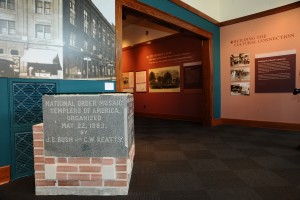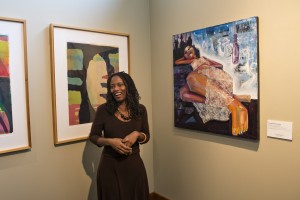Quantia Fletcher’s “heart work” at Mosaic Templars Cultural Center
Editor's Note: This interview is from 2016. The Kinsey Collection is no longer at the museum but other great exhibits are. For more information on current exhibits, visit the Mosaic Templars Cultural Center website.
In celebration of Black History Month, we visited with Quantia Fletcher, the interim director of Mosaic Templars Cultural Center, a Little Rock museum that celebrates African-American history and culture. Quantia—who goes by “Key” (hint: “Quantia” sounds more like the Italian wine Chianti than it looks)—is originally from New Orleans. Her stepfather is from Blytheville, and he and her mother relocated here after Hurricane Katrina. Fletcher and her husband decided to move to Little Rock, where Fletcher began her career with the National Park Service, working at the Little Rock Central High School National Historic Site.
While still new to Arkansas, learning about the history of the state and of Little Rock, Fletcher discovered Mosaic Templars and fell in love with story of the museum. She spent roughly the first half of her now eight years with the museum as its director of education. Her love for the organization has only grown since becoming assistant, and now interim, director, a job she refers to not as hard work, but “heart work,” because she is so passionate about the story of African Americans in Arkansas. She shared that passion with us in a conversation, edited and condensed below.
Arkansas.com: Tell us about the history of the Mosaic Templars Cultural Center.
Quantia Fletcher: The museum is so very important. It actually sits on the foundation of what really is the cornerstone of our history.

It’s in the middle of what was known as the black business district for Little Rock.
This whole area at one point was the African-American community in terms of business and culture. There were barbershops, restaurants, you could get your shoes shined, you could get your hair done, there were doctors and lawyers…all of that was located on 9th street. An organization called the Mosaic Templars of America, which was an insurance company, was also located on 9th street. It was founded by two former slaves: John Bush and Chester Keatts.
Their main function was to provide insurance to African Americans at a time when it was not widely available to them. These two men did something absolutely extraordinary. They started a business, right here where we stand, that was so successful that it included a nursing school, a hospital, a savings and loan and a publication. It grew to be international, in 26 states and 7 countries.
Arkansas.com: What is the MTCC’s mission?
Quantia Fletcher: Our mission is to celebrate, to preserve, and to share the history of African Americans in Arkansas from 1970 to the present—especially in the areas of politics, business and the arts.
Arkansas.com: What are some of your favorite things about working at MTCC?
Quantia Fletcher: Being here early in the morning or really late at night, when nobody’s here, and getting a chance to walk through the exhibits, getting a chance to read the text panels, to touch the artifacts, to really connect with the history on a personal level.
I feel so proud and honored and blessed to be able to share the stories of those who were former slaves, of those who didn’t have a voice, of those who were Arkansas’s first legislators, Arkansas first business-owners.
Never in their minds would they have ever dreamed or expected that there would be a museum erected in their honor to share and continue to tell their story.

Arkansas.com: What’s in store in the future at MTCC?
Quantia Fletcher: We’ve got a new exhibit that’s not only going to change Little Rock, not only going to change Arkansas, but it’s going to change the southern portion of the United States, and that is called the “Kinsey Collection.” This collection is by Shirley and Bernard Kinsey. It started with just a passion they had for collecting African-American culture, history, artwork and artifacts. I’m talking about things like a marriage license between two African Americans from the 1500s.
If you look at our history books, they would tell you that doesn’t exist. And artwork from the 1600s by African Americans. Everybody saw “12 Years a Slave”—they have a first copy of that. They have artwork and artifacts that will make us change the way we look at African-American history. Anybody who really wants to understand African Americans and how their history is a greater part of American history has got to see this exhibit. I get goosebumps talking about it.
